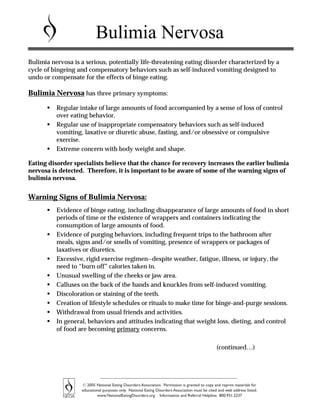Bulimia
- 1. © 2005 National Eating Disorders Association. Permission is granted to copy and reprint materials for
educational purposes only. National Eating Disorders Association must be cited and web address listed.
www.NationalEatingDisorders.org Information and Referral Helpline: 800.931.2237
Bulimia nervosa is a serious, potentially life-threatening eating disorder characterized by a
cycle of bingeing and compensatory behaviors such as self-induced vomiting designed to
undo or compensate for the effects of binge eating.
Bulimia Nervosa has three primary symptoms:
Regular intake of large amounts of food accompanied by a sense of loss of control
over eating behavior.
Regular use of inappropriate compensatory behaviors such as self-induced
vomiting, laxative or diuretic abuse, fasting, and/or obsessive or compulsive
exercise.
Extreme concern with body weight and shape.
Eating disorder specialists believe that the chance for recovery increases the earlier bulimia
nervosa is detected. Therefore, it is important to be aware of some of the warning signs of
bulimia nervosa.
Warning Signs of Bulimia Nervosa:
Evidence of binge eating, including disappearance of large amounts of food in short
periods of time or the existence of wrappers and containers indicating the
consumption of large amounts of food.
Evidence of purging behaviors, including frequent trips to the bathroom after
meals, signs and/or smells of vomiting, presence of wrappers or packages of
laxatives or diuretics.
Excessive, rigid exercise regimen--despite weather, fatigue, illness, or injury, the
need to “burn off” calories taken in.
Unusual swelling of the cheeks or jaw area.
Calluses on the back of the hands and knuckles from self-induced vomiting.
Discoloration or staining of the teeth.
Creation of lifestyle schedules or rituals to make time for binge-and-purge sessions.
Withdrawal from usual friends and activities.
In general, behaviors and attitudes indicating that weight loss, dieting, and control
of food are becoming primary concerns.
(continued…)
Bulimia Nervosa
- 2. © 2005 National Eating Disorders Association. Permission is granted to copy and reprint materials for
educational purposes only. National Eating Disorders Association must be cited and web address listed.
www.NationalEatingDisorders.org Information and Referral Helpline: 800.931.2237
Bulimia Nervosa (continued)
Health Consequences of Bulimia Nervosa:
Bulimia nervosa can be extremely harmful to the body. The recurrent binge-and-purge cycles
can damage the entire digestive system and purge behaviors can lead to electrolyte and chemical
imbalances in the body that affect the heart and other major organ functions. Some of the health
consequences of bulimia nervosa include:
Electrolyte imbalances that can lead to irregular heartbeats and possibly heart failure
and death. Electrolyte imbalance is caused by dehydration and loss of potassium and
sodium from the body as a result of purging behaviors.
Inflammation and possible rupture of the esophagus from frequent vomiting.
Tooth decay and staining from stomach acids released during frequent vomiting.
Chronic irregular bowel movements and constipation as a result of laxative abuse.
Gastric rupture is an uncommon but possible side effect of binge eating.
About Bulimia Nervosa:
Bulimia nervosa affects 1-2% of adolescent and young adult women.
Approximately 80% of bulimia nervosa patients are female (Gidwani, 1997).
People struggling with bulimia nervosa usually appear to be of average body weight.
Many people struggling with bulimia nervosa recognize that their behaviors are
unusual and perhaps dangerous to their health.
Bulimia nervosa is frequently associated with symptoms of depression and changes in
social adjustment.
References:
Gidwani, G.P. and Rome, E.S. (1997). Eating Disorders. Clinical Obstetrics and Gynecology, 40(3), 601-615.
Levine, M. (1994). “A Short List of Salient Warning Signs for Eating Disorders.” Presented at the 13th National NEDO
Conference, Columbus, Ohio.
Zerbe, K.J. (1995). The Body Betrayed. Carlsbad, CA: Gürze Books.
Kendler, K.S., MacLean C., Neale, M., Kessler, R., Heath, A. (1991). The genetic epidemiology of bulimia nervosa. , 1627-1637.

